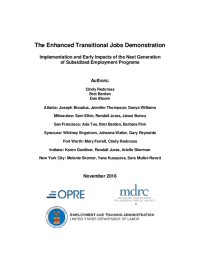Implementation and Early Impacts of the Next Generation of Subsidized Employment Programs
The Enhanced Transitional Jobs Demonstration

Policymakers and practitioners have long searched for program models that can improve employment outcomes for adults who are considered “hard to employ.” Transitional jobs programs offer temporary subsidized jobs that aim to teach participants basic work skills or help them get a foot in the door with an employer; they also help participants address personal issues and find unsubsidized jobs. Several transitional jobs programs have been evaluated, with mixed results.
The Enhanced Transitional Jobs Demonstration (ETJD), funded by the Employment and Training Administration of the U.S. Department of Labor, is testing seven transitional jobs programs that targeted people recently released from prison or unemployed parents who had fallen behind in child support payments. The ETJD programs were “enhanced” in various ways relative to programs studied in the past. MDRC, a nonprofit, nonpartisan research organization, is leading the project along with two partners: Abt Associates and MEF Associates. The Office of Planning, Research and Evaluation in the U.S. Department of Health and Human Services’ Administration for Children and Families is also supporting the evaluation.
The evaluation uses a random assignment research design. Program group members were given access to the ETJD programs and control group members had access to other services in the community. To date, the evaluation has studied the implementation of the programs and followed the two groups for one year after enrollment. Early results include:
-
The ETJD programs were relatively well implemented. All of the programs met their recruitment goals, enrolling 1,000 people into the study. The project succeeded in testing some models that were quite different from earlier programs, but some of the enhanced approaches did not operate as planned.
-
All but one of the programs generated large increases in employment in the early months of follow-up; however, these increases were mostly or entirely the result of the transitional jobs and faded as participants left those jobs. At most sites, the program group was substantially more likely to work than the control group, indicating that the programs employed many people who would not otherwise have worked. There were still modest impacts on employment at the end of the one-year period at most sites. However, these differences were partly attributable to some participants still working in transitional jobs.
-
Two of the three programs targeting people recently released from prison appear to have reduced recidivism (the rate at which they committed new crimes or were reincarcerated). These decreases were concentrated among the participants at the highest risk of recidivism.
-
Most programs increased payment of child support. These impacts were largely consistent with the programs’ impacts on employment, though coordination with child support agencies and some special child support enhancements contributed to the pattern of effects.
It is too early to draw conclusions about the impacts of the ETJD programs. The evaluation will ultimately follow study participants for 30 months, and will include a benefit-cost analysis. A final report is scheduled for 2018.
This 536-page report includes self-contained chapters on each of the seven sites in the Enhanced Transitional Jobs Demonstration.
Front Matter: Overview, Acknowledgments, and Executive Summary
Chapter 2: GoodTransitions (Atlanta, GA)
Chapter 3: Supporting Families Through Work (Milwaukee, WI)
Chapter 4: TransitionsSF (San Francisco, CA)
Chapter 5: The Parent Success Initiative (Syracuse, NY)
Chapter 6: Next STEP (Fort Worth, TX)
Chapter 7: RecycleForce, Inc. (Indianapolis, IN)
Chapter 8: Pathways (New York, NY)






